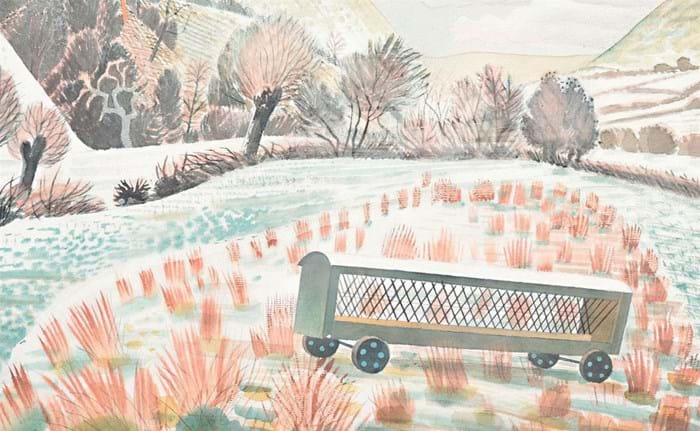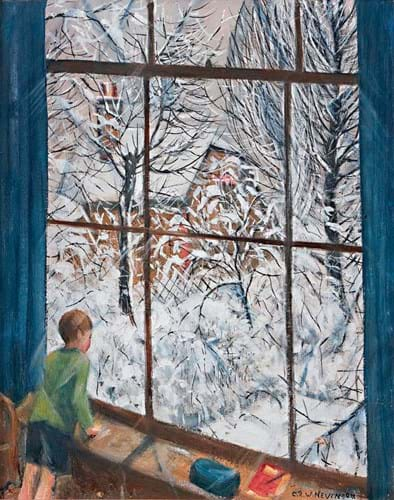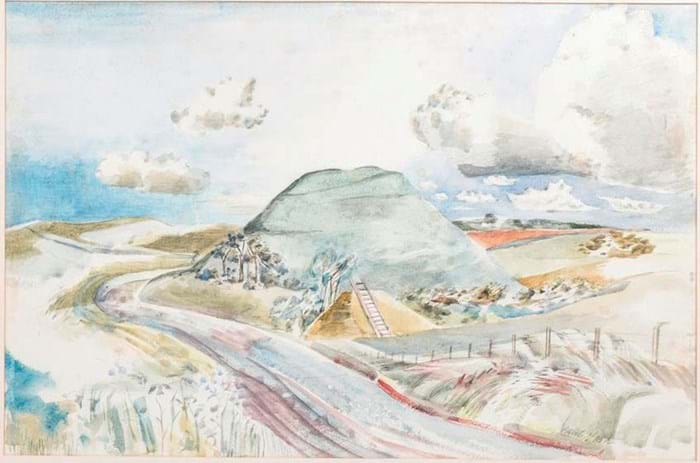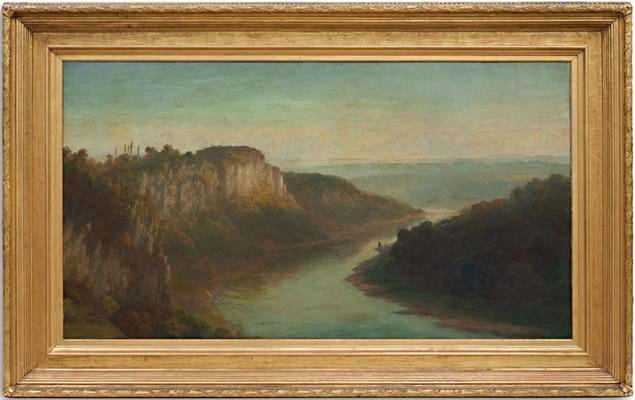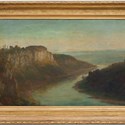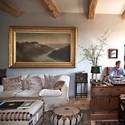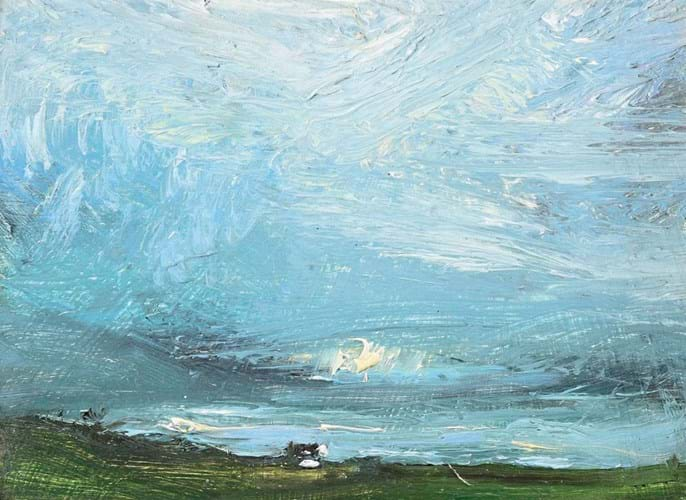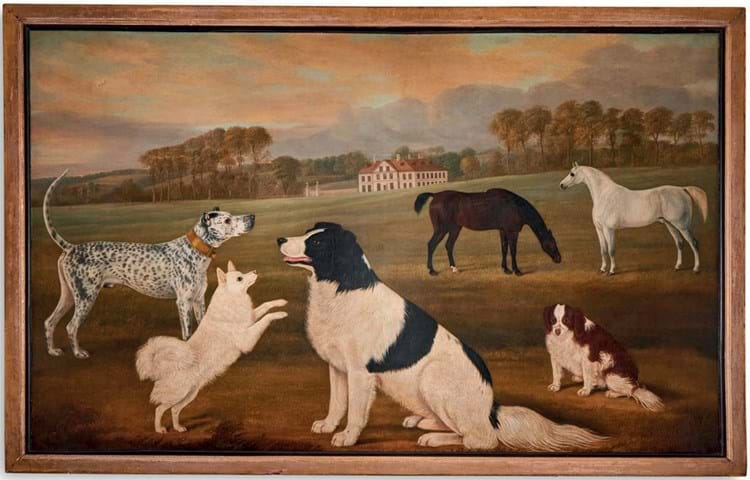
A group portrait of family dogs and horses in the grounds of Clopton House, Warwickshire by William Nedham, £140,000 at Dreweatts’ sale of the Robert Kime collection.
The well-known and impeccably high-end interior designer, who was also a dealer and collector himself, was described as ‘great assembler of beautiful things’. Judging by the in-situ photos in the 3kg two-volume catalogue for the recent auction of his collection, he certainly used paintings and works on paper as a key part of a diverse and eclectic display at his homes in London and Provence.
Kime would often combine curious – and sometimes bizarre – objects with stylish furnishings, something his daughter Hannah described as using “interwoven strands of the remarkable and unremarkable, to assemble an environment that really sang”.
In terms of pictures this could mean hanging pieces of folk art alongside Modern British paintings, for example, to create (again in the words of his daughter) “a place that continually feeds your eyes and soothes your spirit”.
This distinctive style meant Kime had a loyal and affluent clientele, many of whom turned out to bid at the dispersal held by Dreweatts (26/25% buyer’s premium) over three days from October 4-6. With pictures accounting for 200 of the 918 lots, they raised a combined £4.22m (including premium), the largest contribution of any category to the overall £9.6m sale total.
The mix of high-quality and rare pictures, beautifully presented in what felt like a glossy interiors catalogue, along with the added premium of the Kime provenance proved a heady commercial combination.
Dreweatts confirmed to ATG that Kime’s own clients were key players in the bidding wars that broke out in all parts of the sale. But it also reported plenty of interest from other private buyers too, including numerous parties bidding online perhaps looking to create their own Kime-style schemes. Dealers were also active, although it seems in many cases they were outbid as work after work drew high levels of competition, often making sums that were not far shy of retail prices.
Much talk in the trade centred on the top lot. The striking early 17th century ‘English school’ portrait of a man holding a pickaxe and a spade made £400,000 against a £10,000- 15,000 estimate and was pictured in News, ATG No 2613. Selling to a US collector, the price was a major auction record for any piece of English folk art – assuming it could indeed be classified as such (the quality of painting made it anything but a typical naïve picture).
A number of dealers were surprised by the price, especially given its state of preservation, but all of them said the unusual and compelling subject was what drove demand to such unprecedented levels. One member of the trade felt the way that Kime (and indeed Dreweatts) had shown how folk art could be cleverly re-contextualised as part a decorative scheme made such works extremely covetable to the interior designer’s well-off clients.
It was a similar story with another ‘folk’ picture that proved highly sought after. The painting of family dogs and horses by William Nedham (fl.1815-49) also had plenty of compelling features and was incredibly rare. Kime had hung it in the hall of his London home alongside a set of Modern British prints and two Ottoman rugs.
Fewer than 30 works by the artist have appeared at auction according to Artprice.com and this large-scale example was over double the size of almost all the others that have previously emerged. While most of Nedham’s works were more conventional animal paintings, this one was effectively a group portrait of prized animals – a ‘creature conversation piece’ you could say – with a stately composition that made it stand out in his known oeuvre.
The 4ft 8in x 8ft (1.42 x 2.33m) signed oil on canvas depicted the proud owner’s pets in the grounds of Clopton House in Warwickshire, a 17th century country mansion near Stratford-upon-Avon. The animals were identified as a mastiff, a pomeranian, a newfoundland and a spaniel plus the dark brown and grey hunters.
Nedham was a provincial equestrian painter working predominantly in the Leicestershire area. A pupil of John Ferneley Sr (1781-1860), he is known to have produced hunting scenes, equine studies and dog portraits for a number of leading members of the local gentry.
The fact that the picture here was signed and dated 1838 meant that it was almost certainly commissioned by Charles Thomas Warde who had inherited Clopton House the year before. A comparable work, painted on a smaller scale but dated from the same year, is now held by the Leicestershire County Council Museums Service.
The current picture had appeared at auction before. It was offered at a Christie’s South Kensington auction of items from the Kime collection in 2009 (a sale with works also consigned by fellow interior designers and decorative dealers Piers von Westenholz, David Bedale and James Graham-Stewart). Back then it was unsold against a £60,000-80,000 estimate.
This time around it was estimated at a lower level of £20,000-40,000 but it seems the exposure it received by being part of a dedicated and much-publicised single-owner sale made a big difference. After a strenuous competition, it was knocked down at £140,000 to a private collector from the US who was bidding on the phone.
Again some were surprised by the price, not least due to the presence of two tears to the canvas and spots of paint loss and scattered retouching throughout.

The Turn of the Plough by George Gascoyne, £90,000 at Dreweatts’ sale of the Robert Kime collection.
An equally strong competition came for another large painting with an animal subject, albeit later and somewhat different in style. The Turn of the Plough by George Gascoyne (1862-1933) was a 6ft 5in x 13ft 5in (1.95 x 4.09m) signed oil on canvas that had dominated one of the walls of Kime’s dining room.
Billed as a major piece of English social realism, the catalogue noted that the ‘scale, composition, dynamism and grandeur’ arguably showed the artist as the equal of Lucy Kemp-Welch.
In fact, outstripping a £8000- 12,000 pitch and selling at £90,000 to a UK private buyer, it not only made a record for the artist 10 times over (breaking the £9000 record for the same picture when Kime bought it at Christie’s South Kensington in 2012) but the price was higher than any work by Kemp-Welch herself at auction.
Ravilious in the snow
Among a strong showing of Modern British pictures was an important work by Eric Ravilious (1903-42). It was pictured in the catalogue hanging in Kime’s sitting room to the right of a marble fireplace.
The 18 x 22in (46 x 56cm) signed watercolour and pencil from 1938 was titled New Year Snow and it had featured in the exhibition of Ravilious watercolours held the following year at London dealer Arthur Tooth and Son, a show that helped cement the artist’s reputation.
It had been selected as exhibit number 1 and was priced at 18 guineas.
Depicting a picturesque valley near Capel-y-Ffin in the Welsh borders, it demonstrated the way the artist had refined his watercolour technique combining strong lines and a delicate palette mostly applied in single brushstrokes. While such works would become the artist’s recognisable style until his early death, here Ravilious also captured the texture of grassland dusted with snow by allowing the white paper to show through the composition, something that added a shimmering and slightly dreamlike quality.
Kime had bought it at Christie’s sale of Sir Duncan Oppenheim’s collection in 2003. He had bid £30,000 to secure it. Twenty years on and with the Ravilious market having grown significantly, it was estimated at £100,000-150,000 and drew a strong contest before it sold at £280,000 to an private UK buyer bidding online.
It posted the second-highest auction price for Ravilious, behind only the £300,000 for Pilot Boat that sold at Sotheby’s last year – another watercolour that had featured in the same Arthur Tooth exhibition.
An even greater return for a Kime auction purchase came for a Christopher Richard Wynne Nevinson (1889-1946) painting. The interior designer had bought Looking at the Snow for £5800, again at Christie’s back in 1993.
Somewhat removed from the artist’s First World War and Futurist scenes, the 20 x 16in (51 x 41cm) signed oil on canvas showed a boy peering out of a window at the snow covered garden.
Hannah Kime said: “I remember the Christmas that this was given to my mother. It was wrapped, in Kime fashion, in a dust sheet, and when she pulled it off nobody could speak, we were pulled instantly into the poignancy and wonder of the small boy.”
Pitched at £20,000-30,000, it sold at £110,000 to a phone bidder – a strong sum for a less familiar subject by the artist.
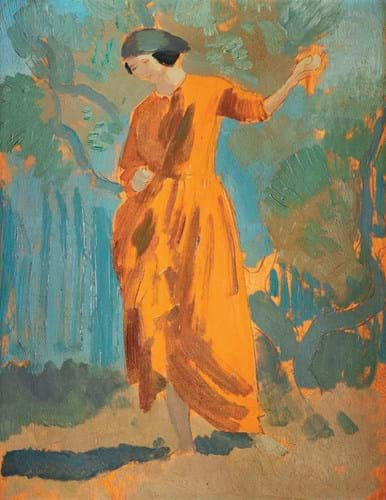
The Yellow Gown (Dorelia) by Augustus John, £145,000 at Dreweatts’ sale of the Robert Kime collection.
Yet another lot bringing an intense competition was an Augustus John (1878-1961) portrait of his muse and mistress Dorelia McNeill. The top prices for the artist have all come for his portraits of either Dorelia or her younger sister Edie and this one always looked likely to attract considerable interest against a £12,000-18,000 estimate.
The 12 x 9¼in (33 x 24cm) signed oil on panel was painted in 1910, the year John rented a villa in the town of Martigues in Provence where he produced a flurry of works by drawing directly onto panel and then painting at speed, leaving small areas of bare wood and pencil showing as was the case here.
The picture was one of 50 panels he exhibited at the Chenil Gallery in 1910 in a show titled Provençal Studies, which are now some of his most sought-after works.
Kime had bought it for £13,000 at Christie’s in 1997 but here it sold at a hefty £145,000 to a UK private buyer on the phone, setting the fourth-highest price for John at auction.
Once again the high return seemed to reflect the ‘Kime premium’ which applied throughout, where bidders with deep pockets were prepared to disregard costs to achieve the desired aesthetic.
Paul Nash watercolour
Silbury Hill, a Paul Nash watercolour that sold for £78,000 to a bidder in the room at Dreweatts. Kime had bought it at Christie’s in 2004 for £28,000.
The site depicted is located near Avebury in Wiltshire and is the largest artificial mound of its kind in Europe. Nash first visited the area in July 1933 where, according to his travel companion Ruth Clarke, he was ‘excited and fascinated’ by the landscape.
Landscape in the study
Thomas Burton Watkin Forster (1821-87) is a little-known painter who was active in Chippenham from around 1859-86.
Although he exhibited at the Royal Academy and the Suffolk Street Gallery, today his works have little exposure at auction with only a handful of results recorded. Most of the few examples that have emerged have sold for under £300.
A large and imposing painting of the Llancaut Crags on the River Wye that was offered at the Robert Kime sale at Dreweatts bought his name into the limelight, however.
The interior designer had spotted the 3ft 5in x 6ft 3in (1.05 x 1.9m) oil on canvas at a Christie’s South Kensington sale in 1998 and bought it for £3450 including premium. Although back then the location depicted was unknown (it was catalogued as an ‘extensive River Landscape’), Kime recognised its decorative potential and later decided to display it in his study at his Provençal home ‘La Gonette’.
Offered the second day of Dreweatts’ dispersal of Kime’s collection on October 5, it was estimated at £3000-5000 but drew a strong bidding battle before being knocked down at £28,000 to an online buyer – an extraordinary sum for an almost unheard of artist.
Contemporary art
Among the lots by living artists at the Kime sale was a group of 14 works by Melita Denaro (b.1950) which all made multi-estimate sums. In total they raised a combined hammer total of £52,200.
The Irish artist has been represented by John Martin Gallery since 2002 and the London dealer told ATG that the painter now has a serious and international following which helped carry these works to greater levels.
“Denaro is a painter of amazing quality”, he said. “Robert Kime was a huge champion of her work and, when she visited Dreweatts ahead of the recent sale, the auction team gave her an incredible welcome. It was very moving.”
The pictures, offered on the second day of the Kime auction, were all small scale panels depicting dramatic seas and skies. The artist grew up on the Isle of Doagh in County Donegal and her landscapes and seascapes showing the changeable conditions and extremes of nature are a prominent part of her oeuvre. These ones were all ‘packed with energy and excitement’ according to the catalogue.
Leading the selection was ‘Calf Moving in Close’, a 5 x 6½in (13 x 17) oil on board which was estimated at £700-1000. It sold at £5500.
While Denaro’s prices on the secondary market have reached up to £8500 for the larger ‘The Intimacy of Solitude’ sold at Sotheby’s in 2015, this was undoubtedly a strong price per square inch. Martin pointed out that the “very personal” and intimate scale of the pictures was “evidently a driving factor behind the most sought-after pieces.
“Robert Kime wrote beautifully about her work and they became great friends so it is especially touching that the support he gave her during his lifetime is still resonating now”, he said.


